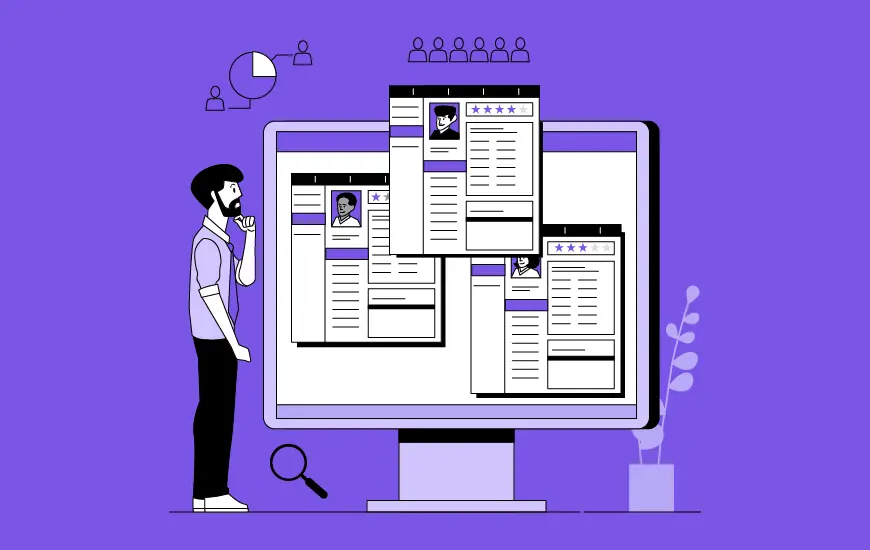- Account Creation and Profile
- A Smooth UI/UX Design
- Must-Have Features of Ridesharing Apps for Riders/Passengers
- Must-Have Features of Ridesharing Apps for Drivers
- How to develop a ride-sharing app?
- Do the Market Research
- Analyze the Value Proposition
- Choose the Development Approach
- Create Your Minimum Viable Product
- Launching & Testing the Product
- Getting Recommendations to Improve your MVP
- Ridesharing App Cost: Estimation for On-Demand Ride-Sharing App Development
- FAQs
Since you are here, it is evident that you have decided to create a rideshare app of your own and join the throng of business owners who are doing the same to capitalize on this expanding market.
It comes as no surprise either since the market value of the international ridesharing apps sector is anticipated to increase from $85.8 billion in 2021 to $185.1 billion by 2026, according to a MarketsandMarkets report.

However, with the abundance of powerful businesses already dominating the industry, including Uber, Lyft, Grab, and BlaBlaCar, to mention a few, it’s more complex than it would appear.
To create ridesharing apps that stand out and perform, many fundamental steps must be taken into account. These include conducting adequate market research, selecting key features, estimating costs, and carrying out a strategic plan.
Since there must be two constituent apps—one for riders/passengers and one for drivers—the fundamental elements needed to build a rideshare app are split into two categories.
The estimated costs for developing such an app in the US are somewhere between $150,000 and $250,000. This is based on the features that are essential to building a functional MVP (minimum viable product).
The costs vary based on the region where you hire your on-demand app development company or individual professionals.
In this article, we will learn about the features you should bring into the mix when working with an on-demand app development company like Appinventiv to create a rideshare app.
Furthermore, we will also learn about the various parts of the development process, including the required tech stack and platforms. Lastly, we will examine the costs involved in rideshare app development. So, let’s get started.
Must-Have Features to Create a Rideshare App
The growing on-demand ride-sharing app business is a lucrative idea for the budding entrepreneurs. To stay abreast in the competitive market of social commuting, it is crucial to include the features that will separate it from traditional taxi service.The features of a ridesharing app have to be divided into the app versions respectively designed for riders/passengers and drivers.
But before we look at these distinct should-have features, let’s learn about the common ones.
Routing, Direction, and Geolocation
The real saviors of successful ridesharing apps are geolocation and routing servers.
The app should have this as its first and most important feature when it comes to carpooling app development. The myth that ridesharing apps solely work on GPS puts the transportation industry entrepreneurs in a plight. To a large extent, it is true, but not entirely.
It conceals the intricate planning and calculation process necessary to calculate the precise route and distance. They wouldn’t be able to rely just on GPS devices for accurate routing and ride-matching procedures; they would also need a routing server.
Account Creation and Profile
The two most crucial aspects that assist you in tracking the user base after a successful rideshare app development are customer and driver registration and profiles.
You can enable users and drivers to complete their registrations using a social networking site or immediately via email to speed up and simplify this procedure. Additionally, you can request their phone number to get added.
You can request that users fill out the necessary information, such as a photo, name, and vehicle license number, specifically for driver profiles. You may also look into a rating and review system to give your app a feature-rich appearance while also giving it a customer-focused feel.
A Smooth UI/UX Design
This consumes a good chunk of the cost of ridesharing app development. To better understand the value of a good UI/UX, consider this:
You could hire different developers and UX/UI designers for Android and iOS app development since both platforms require different frameworks.
Now let’s look at individual features that should be a part of carpooling app development for passenger and driver versions of the rideshare app.
Must-Have Features of Ridesharing Apps for Riders/Passengers

The passenger side of a ridesharing app is significantly different from that of a driver. Therefore, some of the essential features that your new ridesharing app should include on the rider’s side are as follows:
Geolocation
When the riders select the pick-up and drop-off locations, an automatic route map is created by the app, thanks to its geolocation capabilities.
User Profiles
Users’ names, locations, most preferred routes, and preferred modes of transportation should all be listed in their profiles.
Search Filters
Search criteria are crucial since they aid passengers in locating drivers traveling on the appropriate route. Additionally, riders should be able to sort offers based on price, type of vehicle, and even the driver’s gender (for additional safety).
Ride Cost Estimation
Cost estimation based on various routes, types of vehicles, traffic conditions, and more comes in handy in helping riders decide on an option.
Reservations and Cancellations
Users must have access to this option so they can travel at any time and anywhere.
Chat and Call
Chat and call options should be available to facilitate communication and discussion of itinerary specifics on both ends of the journey.
In-app Payment Options
Integration of in-app payment options helps in quick and secure payments, whether clients have to pay for gas, tolls, or driving services.
Push Notifications
Push notifications for offers, discounts, ride status, etc., are crucial features of a carpooling app as they keep the users updated.
You might also want to add the following more sophisticated features:
- Hiring a ride for someone else
- Pre-planning future rides
- Dividing the cost of the ride among friends
[Bonus Read: How to Build a Push Notification Strategy For Higher Conversions?]
Must-Have Features of Ridesharing Apps for Drivers

Regarding the driver’s end of the spectrum, there are certain features you can’t afford to miss out on. The following list includes some of the most basic driver-side features to include in your ridesharing app.
Login
Using this feature, the driver will be able to log into the app using their credentials.
User Profiles
The profile should include data from the driver’s name, phone number, license number, location, and frequently traveled routes.
Accept or Reject Request
Both the travelers’ current position and their final destination will be given to the driver. The request for an assignment might be accepted or rejected by the driver as they see fit.
Trip Information
With this, the driver can evaluate all relevant trip data, including user, pick-up and drop-off locations for fellow commuters, and expected mileage.
Integrated Navigation
This feature aids the drivers in finding the best-suited route toward the pick-up and drop-off locations. The best-suited route is generated based on the real-time traffic conditions on potential routes.
Also Read: Route Planner App Development – Costs, Benefits, Features
Reviews and Ratings
It’s crucial to create a dependable community for your business. Drivers should be able to rate riders and vice versa.
Push Notifications
Push notifications are an important feature that you need to implement in order to build a rideshare app. Drivers can be conveniently reminded to pick up passengers with push alerts.
Contact Passenger
The driver will be able to get in touch with the guests as soon as possible to inquire about the precise pick-up route.
Receive Payments
Using this feature, the driver can effortlessly receive payments from commuters.
How to develop a ride-sharing app?
Now that we have established and understood the must-have features from all the user’s perspectives let us now move to the next step of conceptualizing and developing the actual product, that is, how to build a rideshare app. The steps are mentioned below in listicle format-
Do the Market Research
To ensure the success of any product, analyzing the market is the critical step. As mentioned above, the ridesharing app market is growing rapidly and has a huge potential for simple reasons-convenience and economical transportation.
Although it is well established that the market has huge potential, it is critical to analyze the competitors as well. This will help you in understanding the existing gaps in the already existing applications while providing you an idea of what features can help you differentiate your product from your competitors. Understanding the competitors’ value prepositions and revenue models will boost your confidence in making informed decisions.
All of the above will also help you in identifying the target audience and deciding the niche for your product (in case you plan to do so).
Analyze the Value Proposition
Unless the product does not have a unique feature, it becomes a challenge to establish your app in the market. Thus brainstorming, analyzing, doing thorough market research, and more will help you create a niche in targeting the audience or a feature that will ensure success.
Make sure to choose the features that suit your idea and the market that you wish to target. Based on the same, you can choose the development approach.
Choose the Development Approach
You can build a rideshare app using one of three development methodologies: native, cross-platform, or hybrid. Alongside are mentioned the required tech stacks that you can choose for the specific approaches.
Native App Development
Apps for smartphones that are native to an operating system, such as iOS or Android, is created.
This means that if you want your ridesharing app to run on different platforms, you must create the program specifically for each platform. You must therefore engage both an Android developer and an iOS developer if you want to create a native rideshare app for both platforms.
Therefore, the cost of developing native apps is on the higher side, but they provide a rich user experience and good performance.
Development of native apps uses the following tech stack:
For Android
Java and Kotlin are examples of programming languages. There are also UI frameworks like Jetpack Compose and Android UI and tools like Android Studio, IntelliJ IDEA, and Android IDE.
For iOS
Swift, Objective-C, and other programming languages; tools like XCode, Atom, and AppCode; and UI Frameworks, including UIKit and SwiftUI.
Cross-Platform App Development
In order to build a rideshare app for several platforms (Android, iOS, and web) while using the same codebase you need to go for cross-platform app development.
As a result, this strategy has lower development costs and a shorter time to market. Additionally, certain frameworks for developing cross-platform apps provide performance comparable to native apps.
Cross-platform programming requires the following technology stack:
Well-known frameworks for creating cross-platform apps, including Flutter, Xamarin, and React Native.
Hybrid App Development
Hybrid apps function across various platforms. A hybrid app is one that is created utilizing web technologies like HTML5, CSS, and JavaScript. These apps’ user experience and performance are comparable to native ones but not superior to cross-platform ones.
Hybrid app development requires the following technology stack:
Programming languages such as JavaScript and HTML and frameworks for creating hybrid applications such as Ionic and Apache Cordova.
Now, once you choose your development approach out of these three, it is time to develop an MVP.
Create Your Minimum Viable Product
You have a choice between using an MVP (minimum viable product) or a full product development approach when creating your rideshare app. Building an MVP is a wise choice if your resources are restricted.
The fundamental objective of creating an MVP is creating an app with only the features necessary for defining the app’s value proposition and luring in potential backers and early adopters. The strategy aids in user testing of your concept and gathering feedback for upcoming improvements.
Launching & Testing the Product
Once you’ve created an MVP for your rideshare app, you really must test it with a qualified quality assurance professional before launching it. Once all problems and bugs have been fixed, you can publish your app on the app stores.
Typically, the app stores analyze applications before releasing them to the market, which can take a few days.
Getting Recommendations to Improve your MVP
Obtain consumer feedback following the product launch, so you can decide what changes your ridesharing app has to make to gain momentum. You’ll be on the right track to creating a fully functional product with numerous iterations.
Ridesharing App Cost: Estimation for On-Demand Ride-Sharing App Development
As stated above, there are various factors that contribute to the development of an on-demand application. Some of the crucial factors that will influence the cost to build a rideshare app are as follows:
- The development platform choice (Android, iOS, or cross-platform)
- The project’s technical stack
- The team members that consist of a project manager, iOS and Android developers, backend and frontend programmers, UI/UX designers, and QA engineers.
- The geographical location of the app development company.
A ridesharing app with basic features may cost between $25,000 to $40,000, whereas an application with extensive features may cost you as high as $100,000 to $150,000. Thus, it becomes crucial to hire the right and experienced development partners to ensure the success of your application.
What Role can Appinventiv Play in Developing Your Ridesharing App?
The fast-growing IT consulting and on-demand app development company Appinventiv takes pride in utilizing cutting-edge technologies to build highly-functional apps across an array of sectors effectively. We take pride in providing services to our clients that exceed their expectations, such as rapid software development.
You can choose the features you want to include in your ridesharing app and the route you want to take to development based on the comprehensive information offered above. To establish yourself in the profitable and expanding ridesharing market, we can help you create a prototype or minimum viable product that stands out.
Bluemint Labs collaborated with us to find a solution for a distraction-free driving experience. Our efforts led to the development of a cloud-based application, Actidrive, that gives complete control to the drivers on mobile devices in a touch-free environment. The IoT application developed by using optical technology successfully helps drivers with a safe driving experience.
Through our partnerships with numerous business owners over the years, Appinventiv has helped them become market leaders and boost their operations, so can you, with your ridesharing app idea.
FAQs
Q. How much time does it take to build a ridesharing app?
A. To build a rideshare app, you must first start with creating a viable MVP that can take anywhere from 3 to 7 months, depending on a number of different factors, including the company or professionals you hire to do the job.
Q. What are the different development approaches that one can adopt for their ride-sharing app?
A. Selecting a development approach is the first step in creating a ridesharing app. There are three approaches to developing a ridesharing app: native, cross-platform, or hybrid.
Q. How much does it cost to build a ride-share app?
A. The cost of developing a ride-sharing app with basic features can range between $25,000 to $40,000, whereas an application with extensive features may cost you as high as $100,000 to $150,000.



How Much Does It Cost to Build a Job Portal like Bayt?
In a landscape rife with challenges, the job industry struggles with issues such as skills shortages, fierce competition, and the ever-changing demands of the market. However, the emergence of platforms like Bayt has provided a lifeline for businesses. Bayt transcends the limitations of traditional recruitment by providing businesses with an innovative talent pool. Leveraging advanced…

How Much Does It Cost to Build a Job Portal like Glassdoor?
In the wake of the COVID-19 pandemic, the recruiting industry saw a dramatic change. It has caused many organizations to lose their projects and businesses to shut down, causing many employees to lose their job roles worldwide. In such a scenario finding a suitable job or recruiting the right talent has become one of the…

How to build an online auction application? Benefits, features, costs
When was the last time you went street shopping and bargained with the vendor to sell their products at a lower price? If you remember that experience, imagine bringing it on a digital platform in a more sophisticated way. Websites and applications like Ebay, BidSpotter, and Auction.com, etc. have been making it easy for the…




















